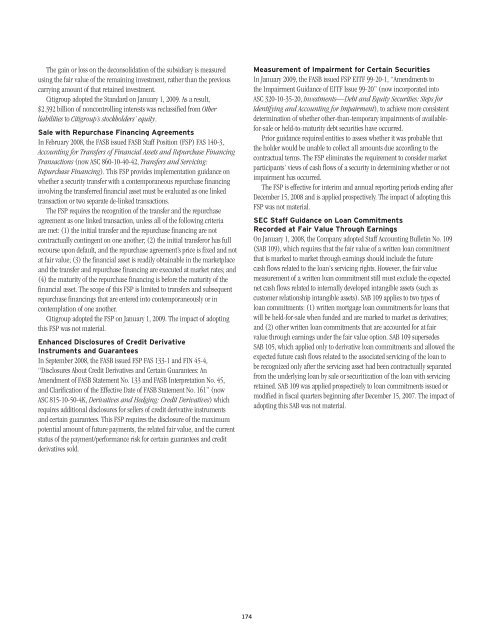Citigroup Inc.
Citigroup Inc.
Citigroup Inc.
You also want an ePaper? Increase the reach of your titles
YUMPU automatically turns print PDFs into web optimized ePapers that Google loves.
The gain or loss on the deconsolidation of the subsidiary is measuredusing the fair value of the remaining investment, rather than the previouscarrying amount of that retained investment.<strong>Citigroup</strong> adopted the Standard on January 1, 2009. As a result,$2.392 billion of noncontrolling interests was reclassified from Otherliabilities to <strong>Citigroup</strong>’s stockholders’ equity.Sale with Repurchase Financing AgreementsIn February 2008, the FASB issued FASB Staff Position (FSP) FAS 140-3,Accounting for Transfers of Financial Assets and Repurchase FinancingTransactions (now ASC 860-10-40-42, Transfers and Servicing:Repurchase Financing). This FSP provides implementation guidance onwhether a security transfer with a contemporaneous repurchase financinginvolving the transferred financial asset must be evaluated as one linkedtransaction or two separate de-linked transactions.The FSP requires the recognition of the transfer and the repurchaseagreement as one linked transaction, unless all of the following criteriaare met: (1) the initial transfer and the repurchase financing are notcontractually contingent on one another; (2) the initial transferor has fullrecourse upon default, and the repurchase agreement’s price is fixed and notat fair value; (3) the financial asset is readily obtainable in the marketplaceand the transfer and repurchase financing are executed at market rates; and(4) the maturity of the repurchase financing is before the maturity of thefinancial asset. The scope of this FSP is limited to transfers and subsequentrepurchase financings that are entered into contemporaneously or incontemplation of one another.<strong>Citigroup</strong> adopted the FSP on January 1, 2009. The impact of adoptingthis FSP was not material.Enhanced Disclosures of Credit DerivativeInstruments and GuaranteesIn September 2008, the FASB issued FSP FAS 133-1 and FIN 45-4,“Disclosures About Credit Derivatives and Certain Guarantees: AnAmendment of FASB Statement No. 133 and FASB Interpretation No. 45,and Clarification of the Effective Date of FASB Statement No. 161” (nowASC 815-10-50-4K, Derivatives and Hedging: Credit Derivatives) whichrequires additional disclosures for sellers of credit derivative instrumentsand certain guarantees. This FSP requires the disclosure of the maximumpotential amount of future payments, the related fair value, and the currentstatus of the payment/performance risk for certain guarantees and creditderivatives sold.Measurement of Impairment for Certain SecuritiesIn January 2009, the FASB issued FSP EITF 99-20-1, “Amendments tothe Impairment Guidance of EITF Issue 99-20” (now incorporated intoASC 320-10-35-20, Investments—Debt and Equity Securities: Steps forIdentifying and Accounting for Impairment), to achieve more consistentdetermination of whether other-than-temporary impairments of availablefor-saleor held-to-maturity debt securities have occurred.Prior guidance required entities to assess whether it was probable thatthe holder would be unable to collect all amounts due according to thecontractual terms. The FSP eliminates the requirement to consider marketparticipants’ views of cash flows of a security in determining whether or notimpairment has occurred.The FSP is effective for interim and annual reporting periods ending afterDecember 15, 2008 and is applied prospectively. The impact of adopting thisFSP was not material.SEC Staff Guidance on Loan CommitmentsRecorded at Fair Value Through EarningsOn January 1, 2008, the Company adopted Staff Accounting Bulletin No. 109(SAB 109), which requires that the fair value of a written loan commitmentthat is marked to market through earnings should include the futurecash flows related to the loan’s servicing rights. However, the fair valuemeasurement of a written loan commitment still must exclude the expectednet cash flows related to internally developed intangible assets (such ascustomer relationship intangible assets). SAB 109 applies to two types ofloan commitments: (1) written mortgage loan commitments for loans thatwill be held-for-sale when funded and are marked to market as derivatives;and (2) other written loan commitments that are accounted for at fairvalue through earnings under the fair value option. SAB 109 supersedesSAB 105, which applied only to derivative loan commitments and allowed theexpected future cash flows related to the associated servicing of the loan tobe recognized only after the servicing asset had been contractually separatedfrom the underlying loan by sale or securitization of the loan with servicingretained. SAB 109 was applied prospectively to loan commitments issued ormodified in fiscal quarters beginning after December 15, 2007. The impact ofadopting this SAB was not material.174
















